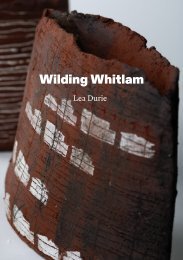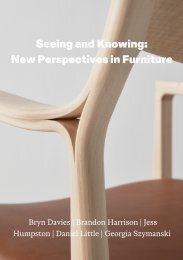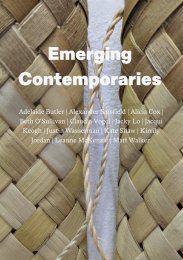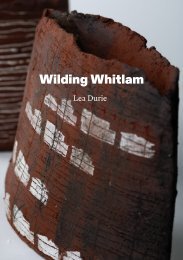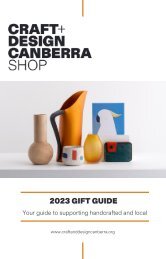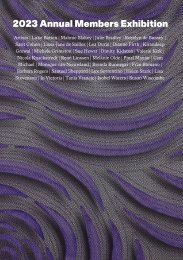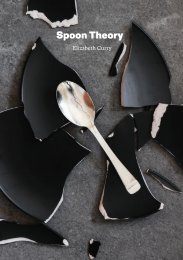Beeing catalouge 2022
You also want an ePaper? Increase the reach of your titles
YUMPU automatically turns print PDFs into web optimized ePapers that Google loves.
<strong>Beeing</strong><br />
Dr Julie Bartholomew and Mahala Hill<br />
Artworks drawing on the natural world<br />
are common across craft, design and<br />
art but it is only relatively recently that<br />
they convey such a sense of urgency, an<br />
urgency mirrored daily in other spheres. In<br />
this show, Julie Bartholomew and Mahala<br />
Hill give voice to one particular area of<br />
concern: the planet’s bee population.<br />
Her research process for this project has<br />
been, as always, rigorous; previously<br />
she has worked with scientists involved<br />
in Antarctic geological investigation<br />
and here she worked with beekeepers,<br />
learning their craft, testing her ideas and<br />
designs.<br />
Bartholomew and Hill met in 2017 when<br />
Bartholomew, then Head of Ceramics at<br />
ANU School of Art and Design, supervised<br />
Hill’s Honours project. Since, their shared<br />
interest in environmental issues has seen<br />
their dialogue develop in ways profitable<br />
for both.<br />
Bartholomew presents two bodies of<br />
work referencing the ovoid beehives<br />
commonly found hanging from tree<br />
branches or attached to other natural<br />
(sometimes man-made) structures. One<br />
group of works is primarily sculptural in<br />
intent while the other can, with minor<br />
additions, act as a functional habitat – a<br />
beehive for a domestic setting. These<br />
latter, in the spirit of ceramics from the<br />
domestic realm, propose answers to<br />
questions. How might a beehive serve<br />
both bee and beekeeper? How might it<br />
be both useful and aesthetically pleasing?<br />
There are distinct echoes in her forms<br />
of a European ceramic heritage with<br />
the glaze, known - appropriately -<br />
as ‘Honey glaze’, along with its red<br />
earthenware clay understrata, familiar<br />
from early English domestic ceramics.<br />
Like all of Bartholomew’s work, all is finely<br />
considered and crafted, with materials<br />
knowledge, construction skills and<br />
attention to detail everywhere evident.<br />
Mahala Hill’s works are also the result<br />
of a keen interest in how material and<br />
process might communicate ideas. Her<br />
works are at once beautiful and fearsome<br />
and although they appear at first glance<br />
to be alien from ceramic tradition, her<br />
materials are clay and glaze, her methods<br />
exaggerations or amplifications of usual<br />
ceramic process. Rather than thin glaze<br />
coatings, litres of glaze are fired in clay<br />
forms then wrenched from the kiln at<br />
high temperatures causing fault lines and<br />
11




